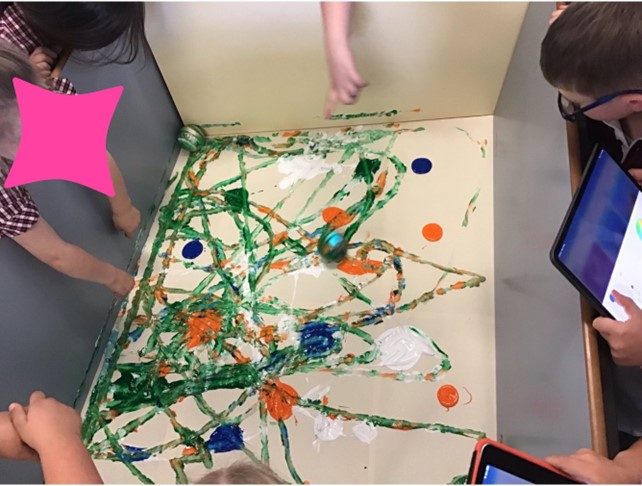Teacher – Kindergarten and Year 1

My mottoes inside and outside the classroom are; failing is how you learn, you can do anything if you have the desire to give it a go, you will never stop learning, and, only compare yourself to yesterday.
Assalamu Alaikum,
I am Mrs Amelia Bowden. I am the Kindergarten and Year 1 teacher and the sports coordinator here at New Madinah College. I completed my Bachelor of Education, Primary, at Western Sydney University. I completed my degree in 2020 and I graduated in 2021.
I began my teaching journey in 2021, at New Madinah College and I have been teaching here since. My passion lies within close knit communities, as I grew up in one myself.
As a child, I was involved in various sports. I was forced to stop when I was diagnosed with a knee disease, so I turned to coaching in-school netball, soccer, and t-ball.
My goal for each student is for them to grow as individuals. This includes within education, but as a person as well. I believe the most important thing is to give everything your best, success will follow.
My mottos inside and outside the classroom are; failing is how you learn, you can do anything if you have the desire to give it a go, you will never stop learning, and, only compare yourself to yesterday.
I have two children and I am a proud Gundungarra woman, and I have learned that many things link between my culture and the Islamic religion.
Something many are shocked about, is that I am an animal lover and I have four dogs, a heap of fish, but most shockingly, a blue tongue lizard. Our lizard likes to come in sometimes and visit during science lessons.
I developed my teaching philosophy whilst at University. If you would like to read more about me, and see how I teach to the teaching standards, please visit my webpage https://ameliabartlett1.wixsite.com/ameliabowden.

My Philosophy on Teaching
For as long as I can remember, I have wanted to become a teacher. As a child, I would use a blackboard and ‘teach’ my toys. Now, I am close to completing my education degree and I truely feel as if this is my calling. My hope for while I am teaching is that the students I teach feel as they can approach me with anything. Also, I believe I can make a positive impact on students and help them achieve their potential. I did not have a positive experience throughout my own education, therefore I would like to be an advocate for students and be the support for students who would normally be left behind.
Throughout my placements, I have experienced schools in low socio-economic areas and middle socio-economic areas, where I have seen students being excluded because they weren’t able to afford uniforms or attend excursions. I believe these students need extra support, rather than being excluded. This is important to me because I have seen the negative impact the lack of support has on students.
Throughout my classroom, I will be incorporating alternate seating, project based learning, inquiry based learning, proximal development and multiple intelligences. I will also be creating a safe and inviting classroom where students feel welcome throughout the day and feel comfortable to approach me with anything they need. As an educator, it is important to know how your students learn, but I also believe that it is important to know your students as the person they are and have a positive relationship to ensure your students feel comfortable around you.
While researching, I came across many theorists and learning theories, though the following have influenced my pedagogy;
- Gardener, multiple intelligences
- Vygotsky, social constructivism
- Vygotsky, proximal development
- Bloom – Bloom’s Taxonomy
Alternative seating has been proven to facilitate students learning by allowing them to choose where and how they would like to sit. For example, a student with ADHD may not be able to sit at a ‘normal’ desk so having an option such as a wobble chair, can help them in concentrating on leaning. Schilling (2006) investigated using alternative seating on students with ADHD and the results demonstrated that students with the opportunity to utilise alternative seating had less behaviour issues. While assisting students learning. This study also demonstrated, students without ADHD or similar disorders still benefit from alternative seating. Throughout my professional experience, I have only been able to use wobble stools and beanbags for different seating. Once I have my own classroom, I am planning on having multiple options for students to choose where they would like to sit.
Project based learning is an important aspect throughout my classroom. Students learn in different ways and project based learning assists kinaesthetic learners. I connect with the following quote – “Tell me and I forget, teach me and I may remember, involve me and I will learn” – Benjamin Franklin. This is one of the reasons I incorporate project-based learning into as many lessons as possible. Project based learning is prominent throughout most of my teaching (see appendix for evidence). Project based learning also encourages engagement while gaining a deeper understanding of the content because students are constructing understanding (Krajck & Blumenfeld, 2006).
Inquiry based learning will be used throughout the majority of my teaching. I believe students should be provided with the opportunity to discover new concepts through investigations. Inquiry based learning has shown to involve multiple problem solving skills, which are vital throughout education and everyday life (Pedaste & Tsourlidaki, 2015). Furthermore, inquiry based learning promotes engagement, therefore lowering negative behaviour which allows more time for learning rather than behaviour management (Fifolt & Morgan, 2019).
Gardener’s multiple intelligences theory is important to me because I have experienced the exclusion from being assessed using one method. For example, I am stronger in linguistic-verbal intelligence but I was left behind in some education because I taught mainly using visual-spatial intelligence. Therefore when assessed, I lacked the ability to recall what was taught. This is why throughout my teaching I will recognise the seven levels of intelligence;
- Visual-Spatial
- Bodily-kinaesthetic
- Musical
- Interpersonal
- Intrapersonal
- Linguistic, and,
- Logical-mathematical
(Gardener, 1993)
In addition to recognising each level of intelligence, I will make adjustment to incorporate each level that students require to ensure no matter how they learn, they will be able to retain and recall information.
Students learn more from each other than what they will learn from you. This is why social constructivism is a necessary approach in my classroom. Throughout each placement, where allowed I have moved the tables to ensure students are able to work in a group and support each other’s learning. Throughout all of my lessons there is opportunity for students to work as a group. Especially throughout problem subjects such as mathematics. I have found when students have the chance to work with their peers, they are more engaged and a can bounce off one another. Although there are some issues with group work, as long as you know your students, it can work. This also accommodates for students who are above average by providing them the opportunity to extend their understanding by explaining the concept to their peers (Cooper, 2002).
Vygotsky recognised there are three zones of proximal development
- Tasks the learner cannot do, even with assistance
- Tasks the learner can do with assistance
- Tasks the learner can do without assistance
(Shanbani, Khatib & Ebadi, 2010). To assist students in completing tasks, I use modelled work in which I explain using different techniques to ensure all students can understand. This motivates the students while allowing for efficient learning. While planning lessons, I take into account the previous knowledge of the students and how they learn to ensure I can maintain development in tasks where students need assistance, as seen in appendix 4. I believe if I set a task that students will not need any assistance, it is not building any skills, but I also believe if a task is to hard and cannot be completed, even with assistance, no skill is being developed either. I utilise Bloom’s Taxonomy throughout my lessons to ensure I am providing students with the opportunity to develop and retain skills. I believe that we as educators should be providing students with the tools to reach their full potential as learners and in my opinion, Bloom’s Taxonomy assists this. While creating lessons and questioning, I use a table provided by Sarah Pacey, 2020, to ensure I maximise learning.

